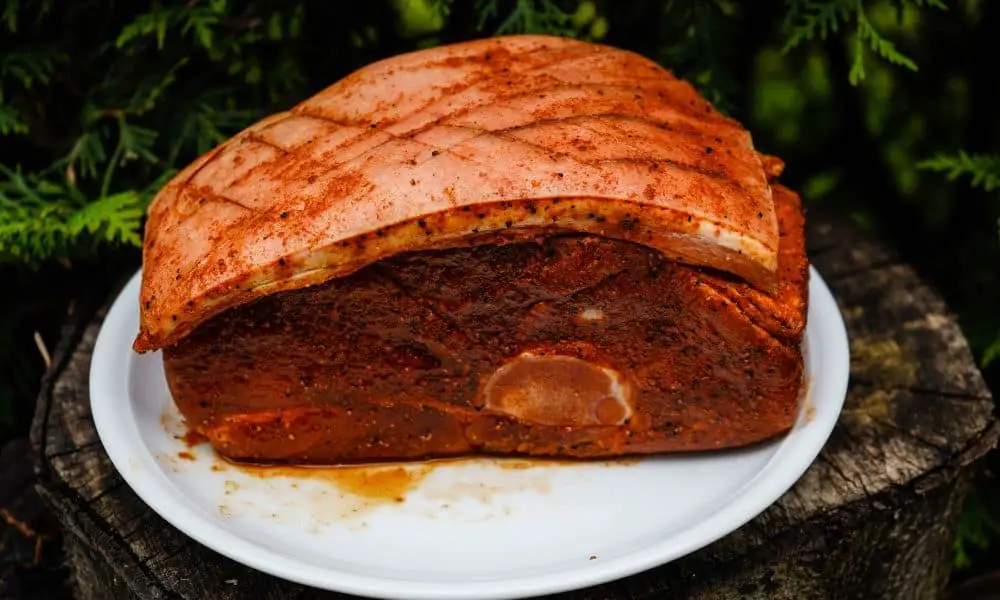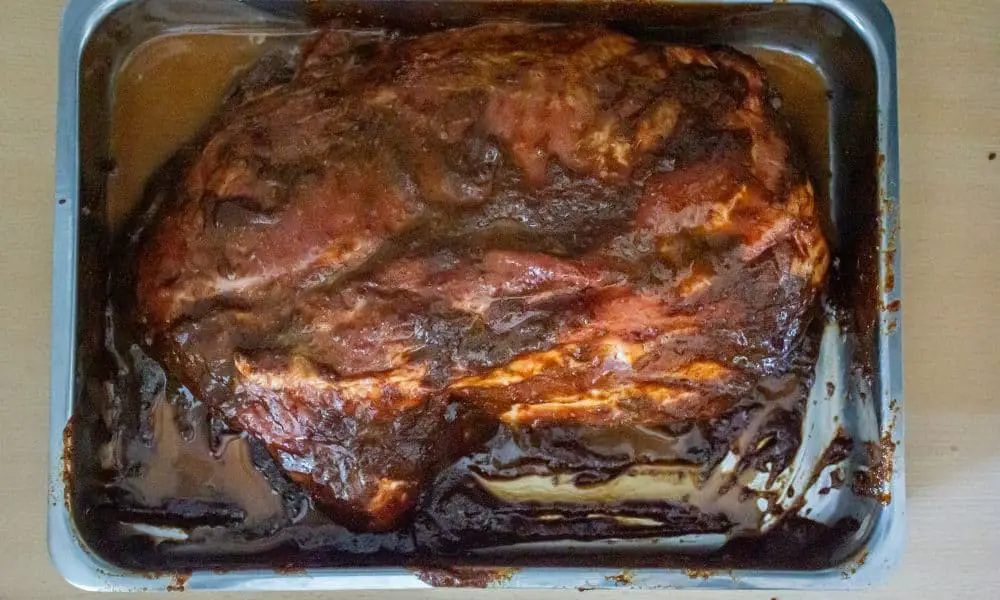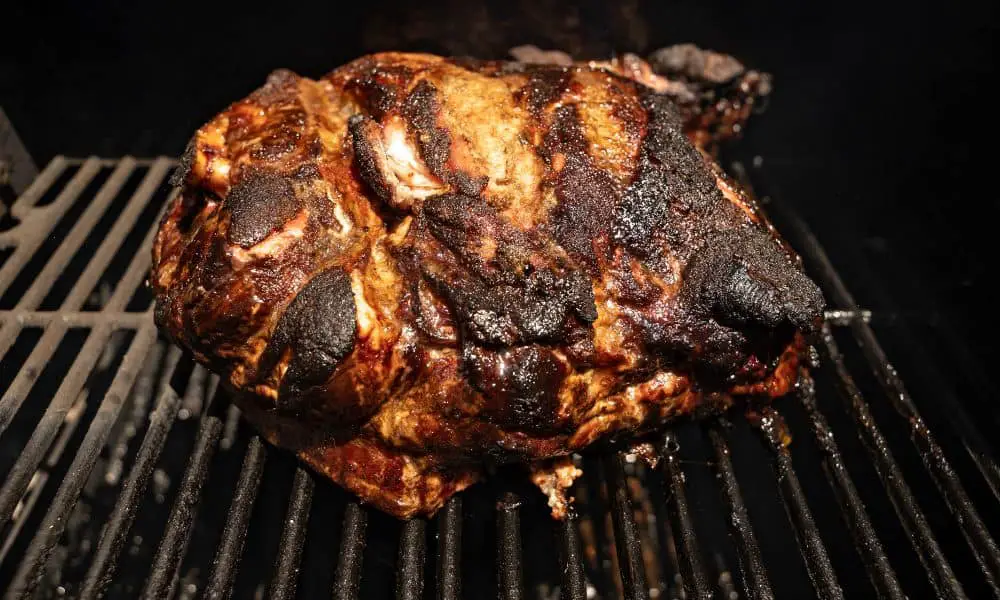When you cook pork shoulder every week, you pick up a thing or two (or three).
Although it’s a rather forgiving cut of meat to play with, there are some techniques that simply make it that much better, whether you’re making pulled pork or a pork roast.
But one age-old debate between pitmasters and professional chefs is: how important is it to actually cook pork shoulder (or pork butt) fat side up or fat side down.
Well, as it turns out, it can actually depend on which direction your heat is coming from. But in most situations, this means placing your pork shoulder fat side up.
The result: a wonderfully chewy bark AND an incredibly tender and juicy hunk of pork.
Quick Verdict: Pork Shoulder Fat Side Up Or Down

To be quite frank, you can still get an absolute banging end result no matter what side up you place your pork shoulder or pork butt.
But, by facing the fat cap up, you help the fat break down, caramelize, create a stunning bark, AND protect the meat from drying out as easily.
- For charcoal grills: You don’t want to grill your pork shoulder directly over the charcoal. Instead create an indirect heat zone, placing your charcoal on one side of the grill, and your pork shoulder on the other side fat side up.
- For ovens, pellet grills, and offset smokers: Place your pork fat side up, as the majority of the heat circulates and normally cooks from above.
- For bullet smokers, drum smokers, or electric smokers: Although fat side up generally yields the best results, if most of the heat is coming from below then you can choose to face your pork fat side down too.
Cooking Pork Shoulder Fat Side Up

If you’re cooking your pork shoulder in an oven, on a pellet grill, or using an indirect heat zone in a charcoal grill, the heat circulates well and cooks the meat on all of its surfaces.
By cooking pork with the fat side up, the fat cap is able to shield the meat from the harsh dry air, helping it stay moist and cook evenly.
As the fat melts, it drips down and bastes the sides of the pork. Although it doesn’t necessarily get absorbed into the meat, it does help keep it moist, absorb additional smokiness, and helps create a delicious bark.
Whether you’re looking to pull your pork or serve it as a roast, cooking your pork shoulder or pork butt fat side up is hands down the superior choice when you’re dealing with any kind of indirect cooking.
- Keeps the whole pork shoulder moist over the cooking process
- Allows a delicious bark or crispy skin to form
- Allows the fat cap to render properly, so you’re not left with chewy or tough fat
- The bottom of the pork can more easily dry out especially if the heat is radiating from below
Some of your dry rub may slough away with the melting of the fat
Cooking Pork Shoulder Fat Side Down
The only situation where I would recommend cooking your pork shoulder fat side down is if you’re cooking with direct heat, OR if most of the heat produced by your cooker comes from below the meat.
In these situations, placing your pork shoulder fat side down actually protects the meat from drying out and cooking too quickly – which can lead to tough pork.
But, if you’re cooking your pork shoulder with indirect heat, like that in an oven, pellet grill, or using indirect heat on a charcoal grill, then placing your pork shoulder fat side down can lead to tougher and drier meat and insufficient breakdown of the fat cap, which isn’t a pleasant texture, believe me.
- Protects the meat against heat from below if cooking with direct heat
- Avoids melting fat juices from unsetting the bark and dry rub sloughing away
Can cause meat on top to become dry or cook too quickly (unless prevented by spritzing or wrapping your pork shoulder during the cook).
The fat cap won’t render as well and won’t crispen up
Pork Shoulder On Charcoal Grill: Fat Side Up Or Down
The beauty of the charcoal grill is that you can set up the charcoal in many different ways, creating direct or indirect heating zones as you please.
For larger cuts of meat like pork shoulder, I prefer to set up a charcoal snake around the perimeter of the grill, with my pork shoulder fat side up smack-bang in the middle.
The heat from the burning charcoal circulates from the sides of the grill, and radiates inward, landing directly on top of the pork.
This is exactly why you want the fat cap facing upward. As the fat renders and melts it moistens the meat, forming an extremely rich and flavorful bark while keeping things moist and juicy.
Pork Shoulder In The Oven: Fat Side Up Or Down

In any standard oven, heat is generated from a fan or grill either at the back or the top of the oven.
In any case, it’s normally circulated all around, designed to evenly cook anything within.
For this reason, you’ll want to place your pork shoulder fat side up in the oven, taking advantage of the heat coming from above.
This helps render the fat, crispen it up and form a nice bark or crispy skin, all while protecting the inner meat from becoming too dry.
Pork Shoulder In A Pellet Grill: Fat Side Up Or Down

Although the fire pot is normally centered at the bottom of the pellet grill, the heat baffle helps to distribute the heat and smoke around the sides of the vessel.
This heat and smoke circulate around the sides of the cylinder and actually ends up enveloping the meat in the center of the grill.
By placing your pork shoulder or pork butt fat side up, you’ll be able to help the fat cap render and melt – keeping the entire piece of pork moist, tender, and oh-so flavorful.
Although the meat on the bottom will have a lesser bark formation, it’s well worth it by the sheer deliciousness of the rendered fat and flavorful bark on the rest of the pork!
Should You Flip Pork Shoulder Over During The Cook?
Sure, you flip a steak when it’s halfway done, so why not a big hunk of pork?
Well, when it comes to pork shoulder, flipping it at any point of the cook can “undo” any of the bark formation processes that’s been happening on the top side of the meat.
Plus, so long as you keep the temperature consistent, spritz if and when necessary, and keep an eye on things, you’ll be able to keep the pork cooking at a steady and even pace.
So, flipping a pork shoulder during the cook can actually do more harm than good.
Instead, what you can do is rotate it every few hours, just to help each side cook evenly.
This is especially true if you’re cooking on a charcoal grill, as naturally it’s hotter on the side that’s facing the charcoal/direct cooking zone.
Quick Recap
If you’re cooking a glorious pork shoulder over several hours or more you want it to come out nothing short of amazing.
Although placing your pork shoulder fat side up or down is a rather simple step in the process, it can make a huge impact on the end result.
If you’re cooking pork shoulder using a charcoal grill, pellet grill, an oven, or any other indirect cooking process, you should always place your pork shoulder fat side up.
The only time you would want to place your pork shoulder fat side down is if the majority of the heat is generated below the meat.
And there you have it!

